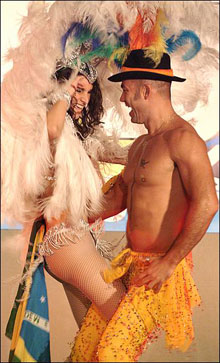
Introduction
 Samba music and dance find their home in Brazil. To a Brazilian, Samba the dance, is a solo dance danced by Carnaval (Carnival) dancers. For ballroom dancers, Samba is a partner dance that many Brazilians will not recognize as a dance with Brazilian roots.
Samba music and dance find their home in Brazil. To a Brazilian, Samba the dance, is a solo dance danced by Carnaval (Carnival) dancers. For ballroom dancers, Samba is a partner dance that many Brazilians will not recognize as a dance with Brazilian roots.
To avoid the use of confusing terminology, we will use the following terms:
Carnaval Samba
Carnival (Carnival) Samba is a solo dance that can be seen danced in the carnival at Rio de Janeiro.
Ballroom Samba
Ballroom Samba is a partner dance that is part of the Latin dances in international style ballroom dancing. Ballroom Samba can travel around the room.
Social Samba
Social Samba is a partner dance that is part of the Latin dances in social North American style dancing. When social Samba is danced in small spaces, the travelling steps are omitted, the steps are smaller, the style is relaxed, and the Samba is danced as a spot dance.
Samba Gafieira
Samba Gafieira (dancehall or club Samba), is a partner dance from Brazil. For further information, follow the link to our page on Samba Gafieira. Samba Gafieira is also called the Brazilian Tango. It is difficult to dance this dance to the Samba music the West has come to recognize.
Forro
Forro is a partner dance from Brazil. Ballroom Samba dancers will be able to recognize some Forro steps. Clink on the link to go to our page on Forro.
Social Samba Moves and Steps
Basic
To start the basic step the leader can step forward or back with either foot. The follower mirrors the man's steps. If the leader steps forward with the left foot, the next step is to bring the right foot to the left foot and the third step is to replace weight on the left foot. The follower steps back with the right foot, then brings the left foot to the right foot and finally replaces weight on the right foot.
The count is 1a2. the 'a' and '2' steps are danced on the balls of the feet for the leader. Samba music is "cut" or syncopated (a dancing term rather than a music term) which means that a soft 'a' beat is added close to the 2 beat, thereby cutting the beat which would otherwise be counted as 1,2.
The basic is completed by the leader doing the back steps just completed by the follower and the follower doing the forward steps just completed by the leader. The count is 3a4.
Box Basic
The Box Basic is similar to the Basic described above. The only difference is that on the second step, the leader steps slightly to the right (the follower to the left) and on the third step the leader brings the left foot to the right foot, while the follower brings the right foot to the left foot. Once again, the basic is completed by the leader doing the back steps just completed by the follower and the follower doing the forward steps just completed by the leader. The count is 1a2, 3a4.
Turning Basic
The Box Basic becomes a Turning Basic with the couple executing anti-clockwise quarter-turn and the second and three steps and again on the fifth and sixth steps. At the end of the first six steps, the couple will have turned 180 degrees on the same spot. In order to maintain Social Samba as a spot dance, the couple should avoid travelling or drifting during the Turning Basic. The count is 1a2, 3a4.
Merengue or Chasse Basic
In the basic step, the syncopated steps are omitted and the steps are danced to the main 1,2,3,4 beats as (say) side-together-side-together steps starting with either foot. With very fast music, the dancers may feel more comfortable using this count.
The Tap Step
Once again with very fast music, the a2 and a4 steps in the basics above can be replaced with a tap step to give a 1 tap, 2 tap count.
Music
 Samba music is intimately connected with Brazil's African heritage and the Carnaval in Rio. While Brazil has produced a rich variety of music, Samba continues to be the music most closely associated with Brazil.
Samba music is intimately connected with Brazil's African heritage and the Carnaval in Rio. While Brazil has produced a rich variety of music, Samba continues to be the music most closely associated with Brazil.
The Carnaval is a parade of musicians, dancers and floats held forty days before Easter to mark the beginning of Lent (and perhaps a last fling before the decorum in behaviour required during Lent and Easter).
Samba music recording began in 1917 with Pelo Telefone by Donga and Mauro Almeida. The music became very popular and the 1920s saw a spurt in Samba compositions. In the 1930s, the Samba composers or sambistas came together to form Samba schools, and today the Samba schools are the primary Carnaval participants.
The are several types of Samba music and the Samba rhythm continues to be a very popular basis from the non-Brazilian composers of Samba music.
Dance Descriptions
» Social Dancing
» Ballroom Dancing
» Ceroc
» Blues
» Glossary
Argentine Tango Descriptions
» Argentine Tango
» Nuevo Tango and Neo-Tango
Latin Dance Descriptions
» Bachata
» Bossa Nova
» Cumbia
» Forro
» Merengue
» Salsa
» Samba
» Samba Gafieira
» Zouk
Videos
» American Ballroom Smooth
» American Ballroom Rhythm
» International Ballroom Standard
» International Ballroom Latin
» Ceroc
» Blues
Argentine Tango Videos
» Argentine Tango Videos
» Nuevo Tango Dance Videos
» Tango Lesson (the movie) Clips
» Tango (the movie) Clips
Latin Dance Videos
» Bachata
» Cumbia
» Forro
» Merengue
» Salsa
» Samba Gafieira